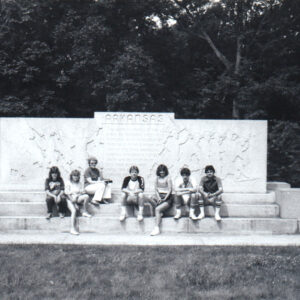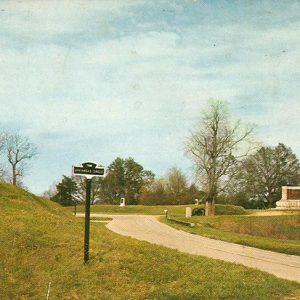calsfoundation@cals.org
Civil War Markers and Memorials (Outside Arkansas)
During the Civil War, soldiers from Arkansas volunteered and served in many skirmishes and battles across the South, often combined with other state regiments. The legislature of Arkansas and interested citizens deemed their service worthy of recognition and remembrance and have therefore provided for several memorials at significant battlefields. Major Arkansas memorials are located at the national battlefields of Gettysburg (Pennsylvania), Shiloh (Tennessee), and Vicksburg (Mississippi). Though not within the scope of this article, there are also monuments to Arkansas soldiers in other locations, such as one located on private land in Tennessee commemorating the role of Arkansas Confederate soldiers in the November 30, 1864, Battle of Franklin.
Gettysburg
The Gettysburg battlefield, first envisioned as a cemetery just after the battle in July 1863, was dedicated with President Abraham Lincoln’s speech on November 19 and officially chartered in April 1864. On February 11, 1895, the War Department took possession of the cemetery and part of the battlefield. The National Park Service was given oversight of the battlefield in 1933, and Gettysburg National Military Park was created. Soon thereafter, states having soldiers engaged in the fighting began erecting monuments to their men who died in the conflict.
In 1965, the Arkansas legislature passed Act 275 authorizing the State of Arkansas Monument Commission, chaired by Judge Neill Bohlinger, to oversee the design and erection of a suitable monument at Gettysburg and appropriating $50,000 for the memorial. This was part of the state’s commemoration of the national Civil War Centennial. The monument was to commemorate “The service of Arkansas troops in the ‘Army of Northern Virginia’ who were present at the Battle of Gettysburg, July 1–13, 1863. Particularly: The 3rd Arkansas Infantry, Col. Van Manning, and Lt. Col. Robert S. Taylor commanding.”
The Arkansas monument was dedicated on June 18, 1966. It is made of Mount Airy, North Carolina, granite blocks with the inscribed outline of the state of Arkansas, and stands eight and a half feet high, twenty feet long, and eight feet deep. “Arkansas” is inscribed in the center of the upright block, with this inscription on the base: “The grateful people of Arkansas erect this memorial as an expression of their pride in the officers and men of the Third Arkansas infantry, Confederate States, who by their valor and their blood have made the ground forever hallowed.” One unique aspect of the Arkansas monument is the four aluminum blocks, one at each corner of the base, with each bearing the Confederate battle flag. These represent Arkansas’s early role as an aluminum producer.
The memorial is placed where the Third Arkansas Infantry Regiment, along with Robinson’s Texas Brigade, formed for the assault of July 2. Arkansas’s one regiment at Gettysburg totaled about 480 men, of which 41 were killed, 141 wounded, and 40 reported missing, meaning that nearly half of the men engaged were casualties.
Shiloh
Shiloh National Military Park began when a group of Union veterans visited the battlefield in 1883 and organized the Shiloh Battlefield Association with the goal of buying what parcels of battlefield land they could and lobbying Congress for more funds to purchase the rest. Congress did so with a bill establishing the Shiloh National Military Park on December 27, 1894. Tennessee ceded land to the park on April 29, 1895, and the park was officially born. However, not until 1901 did states began to erect official memorials. The Arkansas monument of Mount Airy granite was dedicated on September 6, 1910, at a cost of $3,000. Robert Glenn Shaver, a commander of an Arkansas brigade at Shiloh, was keynote speaker at the dedication. The Arkansas United Daughters of the Confederacy paid for the memorial, which looks very much like many courthouse Confederate monuments popular at the time, a single “flag-wrapped” column with a seven-foot Confederate soldier standing and looking into the distance at the top of the twenty-eight-foot memorial. The ten-foot square base contains the dedication and lists the officers and brigades engaged in the battle. The Arkansas monument stands near the famous “Hornet’s Nest,” the site of the fiercest fighting of the battle.
The front of the monument lists field officers of Arkansas troops who were killed or who died of wounds received on the battlefield of Shiloh: “Lt. Col. A.D. Grayson, 13th Arkansas; Lt. Col. John M. Dean, 7th Arkansas; Lt. Col. A.K. Patton, 15th Arkansas; Maj. J.T. Harris, 15th Arkansas; Lt. Col. Charles E. Patterson, 2nd Arkansas, Wounded April 6th, Died April 7th.” The left side of the monument bears the following inscription: “To the brave Confederate dead of Arkansas who fell upon this battlefield. This monument is erected by the Arkansas Div. United Daughters of the Confederacy in the year 1910.” The back side of the monument lists infantry regiments at the battle: “1st Arkansas (Fagan); Gibson’s Brigade, Bragg’s Corps; 15th Arkansas (Patton); Cleburne’s Brigade, Hardee’s Corps; 2nd Arkansas (Govan); 6th Arkansas (Hawthorne); 7th Arkansas (Dean); Shaver’s Brigade, Hardee’s Corps; 8th Arkansas (Patterson); 9th (14th) Arkansas Battalion (Kelly); Wood’s Brigade, Hardee’s Corps; 9th Arkansas (Dunlop); 10th Arkansas (Merrick); Bowen’s Brigade, Breckinridge’s Corps; 13th Arkansas (Tappan); Stewart’s Brigade, Polk’s Corps.” The right side of the monument lists artillery present: “Calvert’s Battery, Shoup’s Battalion; Hubbard’s Battery, Cleburne’s Brig.; Trigg’s Battery, Hardee’s Corps; Roberts’ Battery (Unassigned).”
Vicksburg
The U.S. War Department immediately recognized the importance of the Union victory at Vicksburg, Mississippi, and quickly moved to preserve the area for the men who died there. In 1866, the Vicksburg National Cemetery was established, and more than 18,000 Union dead, as well as two Confederate dead, were interred. Some of the dead were brought from temporary graves as far as 150 miles away. Then, on February 21, 1899, Congress established Vicksburg National Military Park, and states were encouraged to erect memorials to their soldiers who fought at Vicksburg. The 1947 Arkansas legislature appropriated $50,000 for an Arkansas memorial at Vicksburg, which was dedicated on August 2, 1954. It was sculpted out of Georgia marble, with William H. Deacy as the artist. The monument is nearly forty-two and a half feet long, eight feet wide in the center, and features twin twenty-two-foot marble monoliths, representing the divided nation, with a twelve-foot bronze sword between them, embedded like a cross in an altar, which unites the two parts. The inscription on the altar reads: “ARKANSAS: To the Arkansas Confederate Soldiers and Sailors, a part of a nation divided by the sword and reunited at the altar of faith.”
There is a sculpted panel on either side of the altar. The left panel shows Arkansas troops repelling a Union advance, and the right panel shows the ram CSS Arkansas, which fought to defend Vicksburg.
For additional information:
“Arkansas Monument.” Gettysburg National Military Park. https://www.nps.gov/gett/learn/historyculture/arkansas-monument.htm (accessed April 17, 2023).
Davis, William C. Civil War Parks: The Story Behind the Scenery. Fort Washington, PA: Eastern National Park & Monument Association, 2003.
Shiloh National Military Park. http://www.nps.gov/shil/index.htm (accessed April 17, 2023).
Smith, Timothy B. The Golden Age of Battlefield Preservation: The Decade of the 1890s and the Establishment of America’s First Five Military Parks. Knoxville: University of Tennessee Press, 2008.
Vicksburg National Military Park. http://www.nps.gov/vick/index.htm (accessed April 17, 2023).
Paul Haynie
Harding University
 Arkansas Confederate Monument
Arkansas Confederate Monument  Vicksburg Monument
Vicksburg Monument 




Comments
No comments on this entry yet.